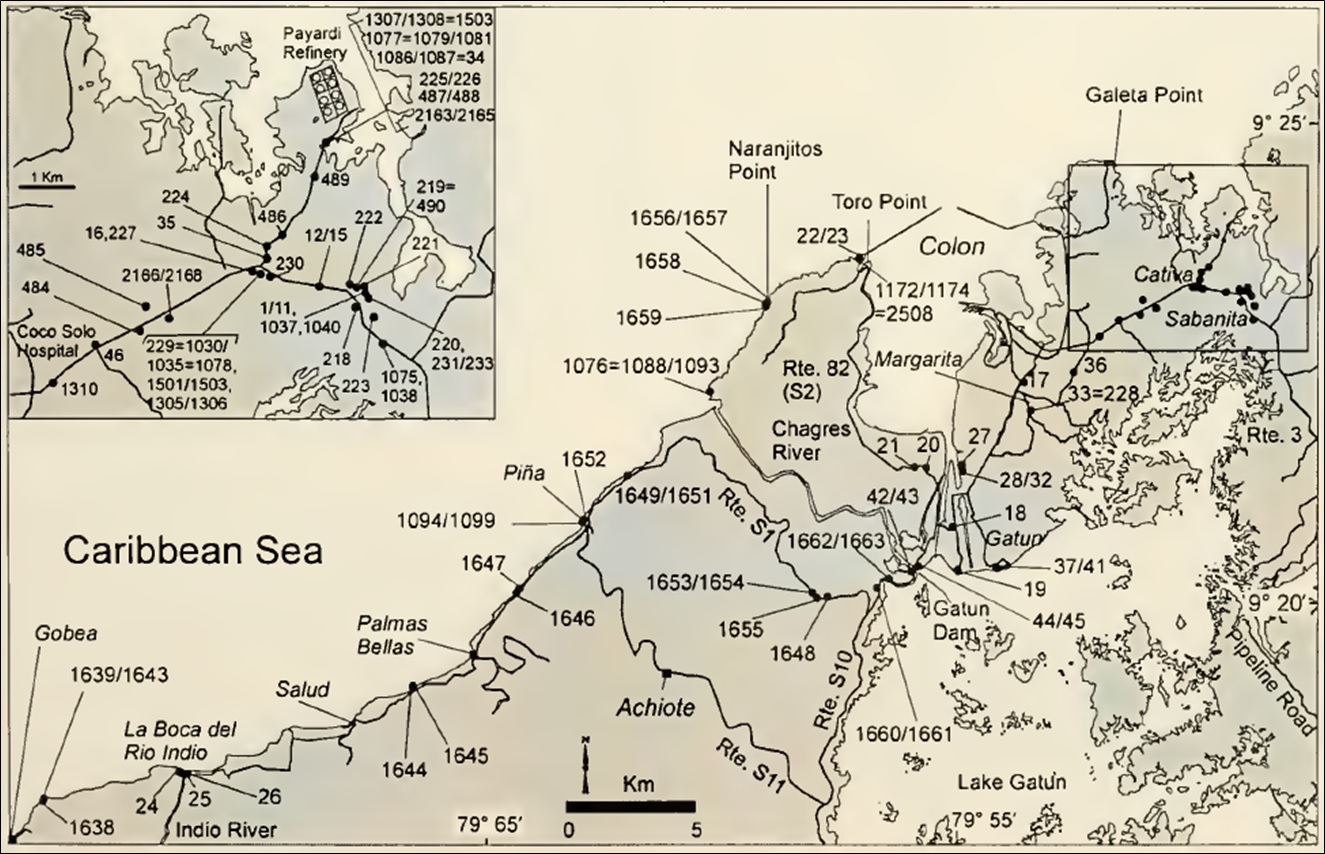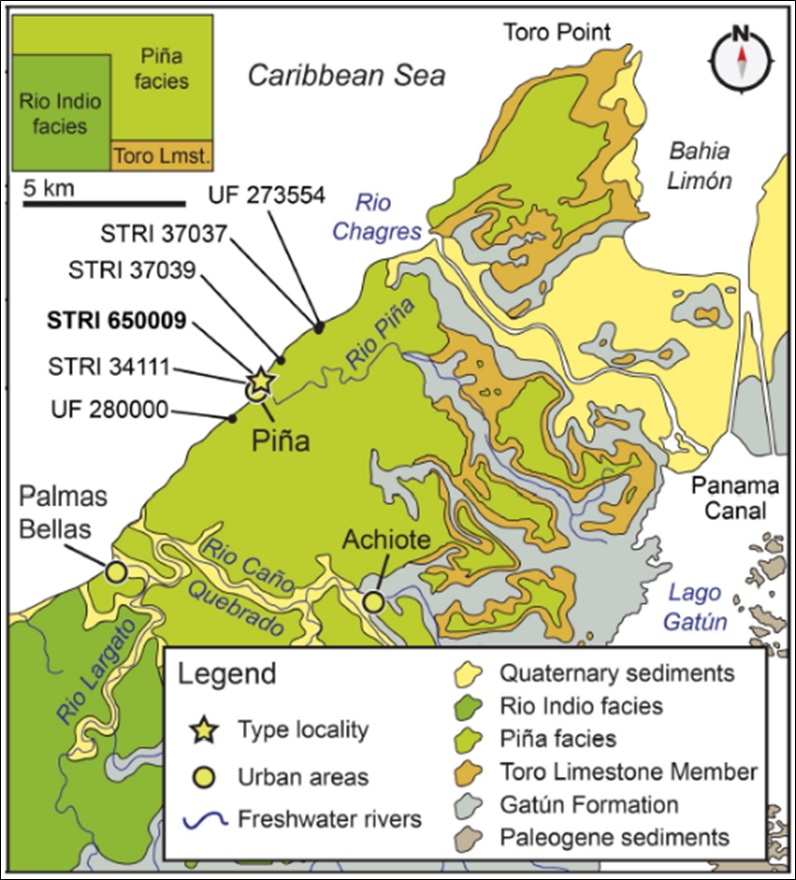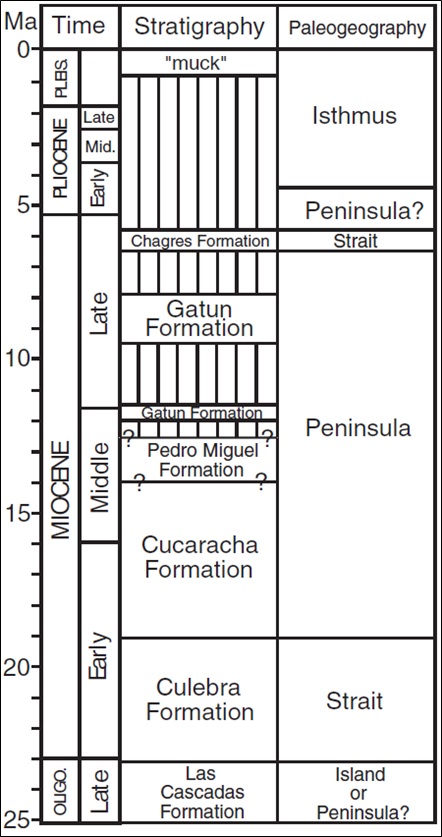Chagres Fm
Type Locality and Naming
The stratotype is diagrammed in Section 3 of Coates (1999). It is exposed from Toro Point to Naranjitos Point (Figure 1). A distinctive lateral facies of the Chagres Fm is exposed at Boca del Río Indio (Figure 1) on the north coast of Panama, approximately 40 km west of Colon. The Río Indio facies is diagrammed in Section 5 of Coates (1999). Sections 3, 4, and 5 of Coates (1999) make up the Reference Section of the Chagres Fm which was revised by Collins et al. (1996). The formation also crops out along the coast as prominent cliffs between Toro Point, at Colon, and the mouth of the Chagres River.
[Figure 1. Colon to Gobea map, Panama Canal area. Appendix A in Coates (1999). (Reproduced with permission of the Paleontological Research Institution, Ithaca, New York).]
Synonym: Chagres Sandstone; Piña” Member
Chagres Sandstone of MacDonald (1919) as listed in Wilmarth (1938). )The “Chagres Sandstone” Member of Carrillo-Briceno et al. (2015) within the Chagres Fm is equivalent to the “Piña” Member/facies of Pyenson et al. (2015).
Lithology and Thickness
The base of the Chagres Fm at the stratotype is distinguished by a distinctive calcareous strata of echinoid-mollusk-barnacle coquina, about 60 m thick, which Woodring (1957) separated as the Toro Member (deep water). It is well exposed in the cliffs west of Toro Point, the headland on the northwest side of Colon Harbor. The Toro Member has a middle portion characterized by about 10 m of steeply cross-bedded, prograding foreset beds, 2-50 cm thick, consisting of alternating coquina and shelly, coarse, volcaniclastic sandstone.
The Toro Member (Figure 2) wedges out about 15 km to the southwest of Toro Point. Its restricted distribution at the northern end of the Panama Canal Basin, with high energy cross bedded coquina and very coarse volcaniclastics associated with bathyal Pacific benthic foraminifera, led Collins et al. (1996) to suggest deposition from a transisthmian strait in which strong currents flushed Pacific sediments and benthos into deep Caribbean waters.
The sandstone Piña Facies (Figure 2) (40-50m thick and ~7.9-5.3 Ma at locality 9° 16' 53.4"N, 80° 2' 40.9"W) is stratigraphically above the Toro Member and is characterized by well preserved benthonic and nektonic fossil invertebrate assemblages (Pyenson et al. (2015)). The high abundance of benthic foraminifera assemblages with modern or ancient upper and middle bathyal depth ranges led Collins et al. (1996) to conclude that the Piña Facies of the Chagres Fm was deposited in deeper waters. Collins et al. (1996) suggested that the Piña Facies were preserved as the Central American Seaway deepened following the deposition of the underlying shallow-water Gatún Fm, and therefore represented the ephemeral formation of a fairly deep (~125 m of water depth) oceanic connection from the Pacific Ocean into the Caribbean Sea, prior to final closure of the Isthmus of Panama. In Carrillo-Briceno et al. (2015), however, paleobathymetry was calculated to be in the shelf, and the Chagres representing a bay rather than a channel.
The Río Indio Member (Figure 2), which laterally replaces the Toro Member to the west, has an age of ~7.64 Ma. This member consists of fine silty-sandstone deposited inwaters of ~50-80 m depth (Collins et al. (1996)). New outcrops of this member, exposed in 2008 during Miguel de la Borda road construction, were studied. They are located on the coast of Punta Mansueto, Donoso District, Colon Province (9° 9' 23.4"N, 80° 17' 36.6"W) (Carrillo-Briceno et al. (2015))
Thickness: The sandstone portion of the Chagres is so massive that estimates of thickness are uncertain. The stratotype in Section 3 of Coates (1999) shows a thickness of 215 m however, Collins et al. (1996) state that the Chagres Fm is ~250 m thick, marine, and predominantly an arc-derived, volcaniclastic sandstone. The basal unit is the Toro Member, 60 m of lime-cemented barnacle and echinoid coquina interbedded with shelly, coarse sandstone. A distinctive feature of this unit is a 10m-thick, steeply cross-bedded unit that has prograding foresets ~2–50 cm thick. Field observations indicate that the Toro Member wedges out to the west, and the average grain size of the Chagres Fm progressively decreases from very coarse sandstone and coquina at Toro Point to medium to coarse sandstone northeast of Palmas Bellas, to silty fine sandstone and silty claystone at Río Indio.
[Figure 2. Distribution of the Chagres Fm, with type locality of Isthminia panamensis (dolphin) with other fossil vertebrates. The relation between the three facies is shown on the top left. Pyenson et al. (2015).]
Relationships and Distribution
Lower contact
Upper contact
Regional extent
GeoJSON
Fossils
Fish; Mammals (dolphin Isthminia panamensis); Invertebrates (echinoids, mollusk (Smith (1991)), barnacle). Carrillo-Briceno et al. (2015) also describe a shark fauna from the Río Indio and Chagres Sandstone (Piña) Members just east and west of the town of Piña. Velez-Juarbe et al. (2015 & 2019) mention a cetacean from the formation (Kogiid Sperm Whales). Vigil & Laurito (2014) describe a fragment of a crown and an isolated lower commissural tooth of a sperm whale of the Family Physetheridae. Fierstine (1978), describes a Marlin (Fish - Makaira panamensis) from a single neurocranium found on the Atlantic shoreline of Panama, approximately 17 km southwest of Colon, Canal Zone.
Age
Depositional setting
The Toro Member, Its restricted distribution at the northern end of the Panama Canal Basin, with high energy cross bedded coquina and very coarse volcaniclastics associated with bathyal Pacific benthic foraminifera, led Collins et al. (1996) to suggest deposition from a transisthmian strait in which strong currents flushed Pacific sediments and benthos into deep Caribbean waters.
The sandstone Piña Facies, paleo-bathymetry was calculated to be in the shelf, and the Chagres representing a bay rather than a channel by Carrillo-Briceno et al. (2015).
The Río Indio Member consists of fine silty-sandstone deposited in waters of ~50-80 m depth.
Additional Information
References:
Relevant documents discussing the Unit:
- Woodring & Thompson (1949). Includes Toro limestone Member at base. Chagres proper above Toro Member consists of very massive mostly line-grained sandstone and some siltstone. Thickness difficult to determine; MacDonald considered it to be 1,000 feet or more. Overlies and partly overlaps Gatún Fm; base sharply defined. Fossil evidence indicates late Miocene age; however, it may be early Pliocene if the coastal Gatún west of Canal Zone is late Miocene.
- Jones S.M. (1950);
- Woodring (1955). Lower Pliocene
- Woodring (1957).
- Woodring (1960). Most of the sandstone is fine-grained. Unlike the unconformably underlying Miocene Gatún Fm, the Chagres sandstone includes no tuff or conglomerate. The sandstone extends along the Caribbean coast at least as far as 23 miles southwest of Colon. The fossils include Acila isthmica, Aequipecten cactaceus, and Dentalium rimosum. This molluscan fauna indicates an early Pliocene age.
- Woodring (1982); Fierstine (1978); Smith (1991); Collins et al. (1996); Coates (1999); Beu (2010); Landau et al. (2010 & 2012c); Montes et al. (2010); Jaramillo et al. (2014); Vigil & Laurito (2014); Carrillo-Briceno et al. (2015) ; Velez-Juarbe et al. (2015); Pyenson et al., (2015); Velez-Juarbe et al. (2015 & 2019).


